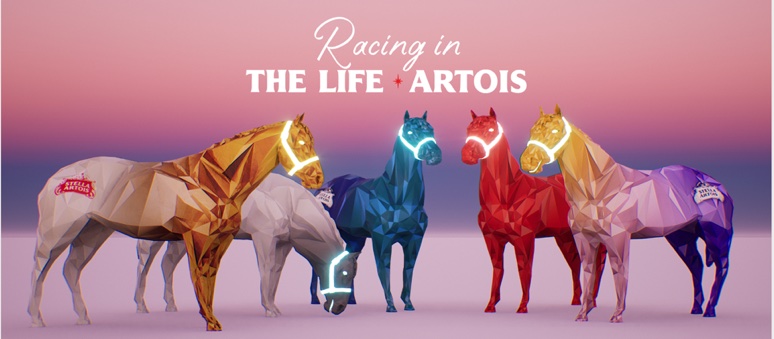‘Bullish on the space’: Why Anheuser Busch InBev is testing NFTs in its marketing

Despite the cynics, non-fungible tokens are still going strong after the surge in attention they got in March. The narrative has gone from get-rich-quick schemes to a more nuanced future. Sure there will be losers, but there will be more insights to glean from future success stories.
Marketers at Anheuser Busch InBev hope this is especially true for NFTs and the metaverse. By metaverse, the brewer means the convergence of the physical and digital worlds across separate and interwoven systems. NFTs will be the building blocks between those systems, said Lindsey McInerney, global head of technology and innovation at AB InBev.
Her rationale being that NFTs are essentially a bridge between these environments, from real to virtual to social. NFTs do this by providing scarcity (a real-world property) as the digital deed to virtual items that don’t natively have that property. This so-called “bridge” concept is the reason why NFTs aren’t a passing fad, said McInerney.
“This isn’t an if situation — It’s happening. We’re already living in mixed reality,” said McInerney. “I’m incredibly bullish on the space. We’re early in the formation of the metaverse but it’s happening fast thanks to the pandemic.”
This cultural tokenization of the metaverse is like a catnip for marketers who want to see how far it can be pushed. For AB InBev’s marketers, this starts with virtual horse racing. The sport’s popularity has swelled in tandem with interest in NFTs. In fact, the horses in these virtual races are NFTs meaning they exist as digital assets. Owners can make money from selling, racing or breeding these horses just as they world in the real world. The NFTs contain unique characteristics like coat type that are passed on when comingled together.
Starting yesterday, bidders can now compete in auctions to win a virtual horse as well a Stella Artois-branded skin and an art piece in the style of the brand. There are 10 of these bundles up for grabs across five daily auctions until June 19. McInerney declined to share any further detail on how the auctions are being managed or who receives the funds generated from the auction. However, virtual horses can cost eye-bulging sums. One player sold a stable full of racehorses for $252,000, per The New York Times, while another made $125,000 for a single racehorse.
The inherent value in these virtual horses is compounded by the fact that they’re in limited supply. Indeed, there are horses that have never won a, race but are growing in value because of this scarcity and individuality baked into the NFT. Digital horse racing platform Zed Run is at the forefront of this trend, which explains why AB InBev struck up a partnership around the latest horses people can buy and race there.
“While the [NFTs] concept is new, it makes sense to apply scarcity to luxury things that are more scarce and aspirational in the real world,” said Will Luttrell, chief technology officer at brandtech group You & Mr Jones. “Gucci handbags and rare NFT racehorses certainly apply. This maximizes the power of the NFT to provide the scarcity property virtually.”
Beyond brand extensions, there are multiple ways marketers can use NFTs. For starters, there’s attribution and fraud protection. NFTs record a history of ownership on a blockchain, which a marketer could see and verify via a distributed network. By the same logic, marketers could also build, manage and monetize digital assets.
“The opportunities here are endless,” said McInerney, who is already exploring other use cases for NFTs. “The metaverse will be bigger than Facebook, more immersive than YouTube and more profitable than Amazon. It’s an exciting but early time to be working in this area.”
Following the consumer to where they are spending their time is not a new concept for advertisers. So it’s no surprise then that AB InBev isn’t one of a few advertisers sizing up NFTs.
“Brands are clamoring for NFTs,” said Alanna Roazzi-Laforet, publisher and CRO of cryptocurrency publisher Decrypt. “We are fielding a myriad of requests and will soon be launching a solution to assist our marketing partners in navigating the NFT and more importantly, the digital asset space,”
Still, the metaverse is hardly a new concept. From Second Life to online chat rooms and everything in between, marketers have been weighing up how and when to show up in these online environments for years. Now, however, they have the opportunity to transact between these environments using blockchains such as Ethereum and using token swaps to convert to the token of their choice.
“There is a specific mindset in the metaverse,” said Roazzi-Laforet. “Take CryptoVoxels for example. People hold live social events, buy digital plots, and create a homesteading approach. Marketers need to be respectful of these pioneers and create messaging that speaks to their resourceful spirit.”
More in Marketing

Pitch deck: How Amazon is recasting Twitch as a core part of its CTV pitch
Amazon is positioning Twitch as a defining asset in its CTV ambitions.

Netflix transforms former mall department stores into experiential venues
The location in Dallas opens this week, and one at the King of Prussia mall near Philadelphia opened last month.

Future of Marketing Briefing: AI has created a new talent paradox in programmatic agencies
The job isn’t execution anymore. AI handles that. The job is judgement.








